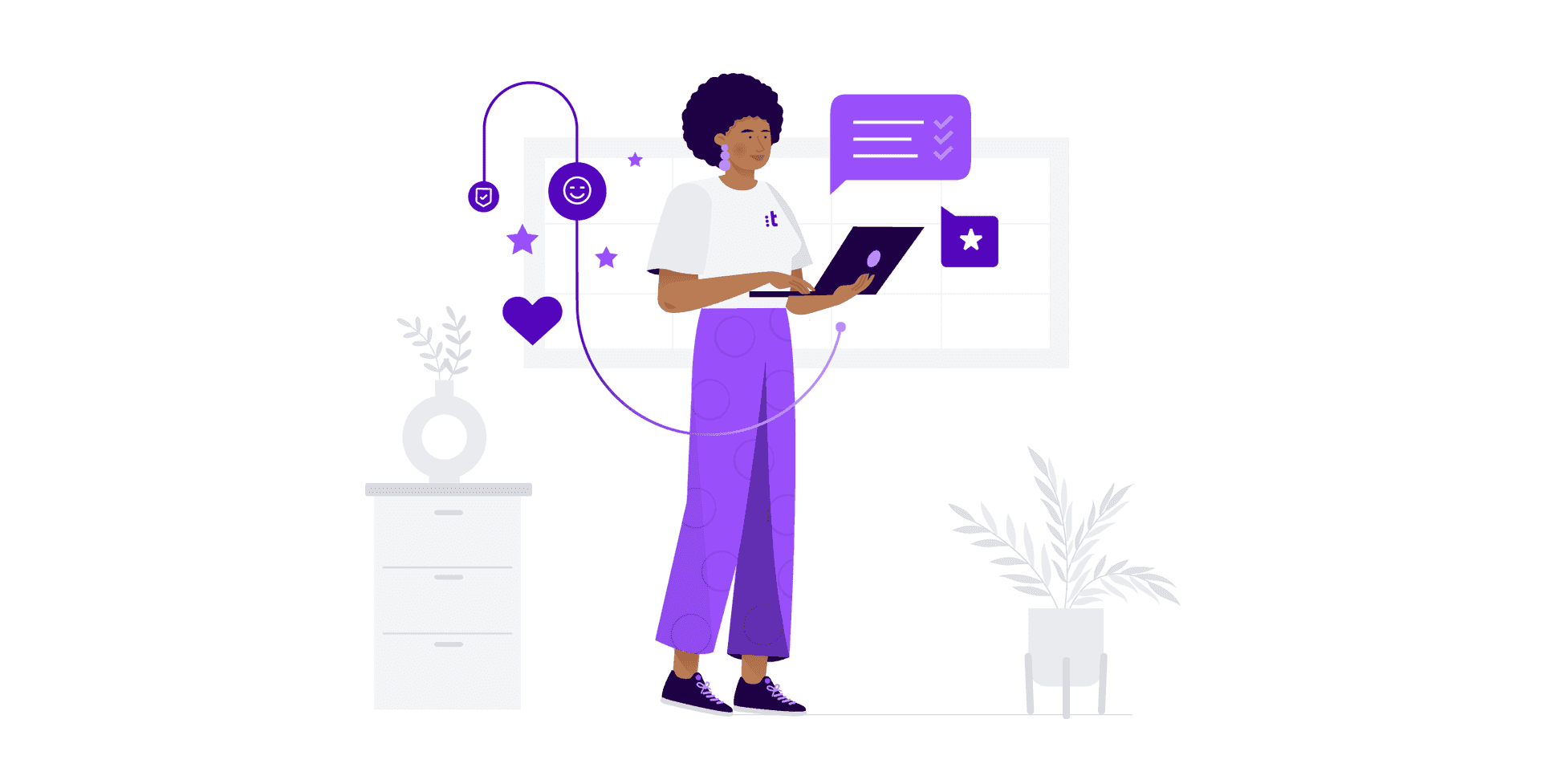20 maneiras de usar recompensas para motivar os colaboradores

Por Celia Cerdeira
0 minutos de leitura

Sem agentes motivados, os contact centers podem ser confrontados não apenas com altos índices de rotatividade de colaboradores, mas também com a fraca satisfação do cliente.
É por isso que é tão importante encontrar maneiras de melhorar a participação dos colaboradores e mostrar a eles que você se importa. Uma das melhores maneiras de fazer isso é através de programas de recompensas.
Pode ser um pouco complicado encontrar recompensas para motivar os colaboradores que também se ajustem ao seu orçamento e, por isso, apresentamos algumas dicas.
Como motivar os colaboradores.
Enhancing employee motivation through rewards doesn’t have to be a daunting task for managers. With the right techniques and industry-leading cloud call center software, managers can expertly utilize rewards to boost employee motivation. Empower your workforce with incentives such as bonuses, gift cards, time off, recognition awards, and heartfelt words of appreciation. These rewards reinforce desired behaviors, build loyalty, and foster high levels of employee engagement.
Os managers que estão desenvolvendo, reformulando ou atualmente implementando um programa de recompensas para colaboradores devem considerar estas 20 dicas:
1. Envolva todos os colaboradores no desenvolvimento, implementação e revisão dos programas de recompensas.
Envolver todos os colaboradores (ou representantes de diferentes cargos) incentivará a comunicação entre os colaboradores e a direção sobre o processo de recompensas. Também garantirá que os colaboradores e a direção superior estejam de acordo relativamente ao sistema de recompensas.
2. Certifique-se de que os colaboradores vejam as recompensas como valendo o esforço.
Incluir os colaboradores no processo de desenvolvimento do programa de recompensas é fundamental para garantir que valorizem as recompensas e as vejam como valendo o esforço. Os managers devem valorizar a entrada de colaboradores e selecionar as recompensas de acordo. Os colaboradores que veem as recompensas como valendo o esforço estarão mais motivados a trabalhar duro para obtê-las.

3. Certifique-se de que os colaboradores entendam como ganhar as recompensas.
Os managers devem delinear claramente como os colaboradores podem ganhar recompensas. Quando os colaboradores tiverem uma compreensão abrangente do que se espera deles, serão mais capazes de atingir os padrões de desempenho.
4. Estabeleça padrões de desempenho razoáveis e transparentes para recompensas.
Employees must see the rewards as attainable to engage in the necessary effort to obtain them. Check in with employees to ensure that they believe the rewards are within their reach. Also, providing employees with a dashboard where they can view their performance in real-time will allow them to accurately assess their own performance and have realistic expectations for rewards.
5. Baseie as determinações de recompensas em dados de desempenho objetivos.
When motivational incentives for employees are distributed based on objective data, they are more likely to view the process as fair and have a concrete understanding of what is expected of them. This will increase their motivation to achieve the desired performance results.
6. Certifique-se de que os colaboradores vejam o sistema de recompensa como justo.
Quando os colaboradores veem o sistema de recompensa como justo, sentem-se mais empenhados em tentar obter a recompensa. As recompensas devem ser distribuídas consistentemente de acordo com políticas pré-determinadas. Nunca se envolva em favoritismo nem tome atalhos, pois terá um impacto negativo no desempenho dos colaboradores
7. Associe sempre recompensas a desempenho
Para que as recompensas tenham o maior impacto na influência do desempenho dos colaboradores, devem estar diretamente associadas ao comportamento desejado Associe elogios, reconhecimento, recompensas monetárias e recompensas não monetárias a resultados específicos. Quando os colaboradores compreendem a ligação entre a sua recompensa e o seu desempenho, ficam motivados a ter um melhor desempenho no futuro.
8. Reconheça pequenas e grandes realizações.
Os colaboradores devem ser recompensados quando atingem grandes objetivos, mas também marcos menores. Isto garantirá que recebam reconhecimento pelo seu progresso e que o seu comportamento seja consistente com as expectativas da empresa.
9. Recompense o trabalho em equipe e a cooperação.
Team-based incentives were found to be more effective at increasing performance than individual incentives. If team-based rewards to motivate employees are not already included in the company strategy, they should be. Additionally, the resources devoted to team-based rewards should be substantial. This could have a significant impact on employee cooperation and the company’s bottom line.
10. Nunca tome como garantido o bom desempenho.
É fácil parar de recompensar os colaboradores que têm o melhor desempenho, mas isso pode ser uma falha fatal Para manter os melhores talentos na equipe, certifique-se de que a sua empresa continua a reconhecer e recompensar um excelente desempenho.
11. Ofereça recompensas imediatamente após o colaborador atingir o comportamento desejado.
Existe um componente temporal para o efeito da recompensa. Quanto maior o atraso no fornecimento da recompensa após a conquista do colaborador, menor o impacto que tem em moldar o comportamento subsequente. Recompense imediatamente o comportamento que cumpre os padrões de desempenho.
12. Combine a recompensa com o colaborador.
Permita que cada colaborador selecione a sua própria recompensa ou decida quais recompensas os colaboradores devem receber sob circunstâncias predefinidas. Tal fato aumentará o seu compromisso de alcançar a recompensa, envolvendo-se no comportamento exigido. É fundamental para este processo compreender as necessidades dos colaboradores.
13. Ofereça recompensas financeiras, recompensas não monetárias e reconhecimento.
Há muitos tipos diferentes de recompensas para motivar os colaboradores, mas os sistemas de recompensa que incluem uma combinação de recompensas monetárias e não monetárias, bem como prêmios sociais, como reconhecimento e elogios, têm o maior impacto no desempenho dos colaboradores. Pague o bônus em dinheiro em uma quantia fixa para maximizar o seu efeito, pois o dinheiro só motiva quando é uma quantia significativa.
14. Quando os colaboradores aprendem uma nova tarefa, distribua recompensas com base em um calendário de reforço contínuo.
A forma mais eficaz de incentivar a aprendizagem de uma nova tarefa é reforçando o comportamento dos colaboradores em um calendário contínuo. Isto pode exigir um esforço considerável quando executado por um manager, no entanto, utilizar um programa de software de recompensa dos colaboradores é uma solução mais viável e rentável.
15. Quando o comportamento se tornar um hábito, distribua recompensas com base em uma razão variável ou um calendário com um intervalo variável.
A razão variável e os calendários de reforço de intervalos variáveis resultam na mudança de comportamento mais significativa, uma vez que o comportamento se torna um hábito. Essa mudança de comportamento também é mais resistente ao enfraquecimento. Portanto, um destes calendários de reforço deve ditar o processo de distribuição de recompensas após o comportamento se tornar um hábito.
16. Não divulgue o valor em numerário das recompensas não monetárias tangíveis.
Os colaboradores que desconhecem o valor exato em dinheiro das recompensas não monetárias são mais motivados pelas mesmas. Não divulgue o valor, a menos que seja necessário.
17. Use programas de recompensas de longo prazo.
Os programas de recompensas de longo prazo têm o maior efeito no desempenho dos colaboradores e os ganhos resultantes duram mais tempo.
18. Equilibre programas de recompensa competitivos com programas não competitivos.
Os programas de incentivo competitivos são tão eficazes quanto os programas de recompensa não competitivos no aumento do desempenho. Uma estratégia eficaz de recompensas deve incluir ambos.
19. Torne as recompensas parte integrante da estratégia da empresa.
Os incentivos motivacionais para os colaboradores são inestimáveis para alinhar o comportamento dos colaboradores com a estratégia comercial da organização. Certifique-se de que o comportamento recompensado esteja de acordo com os padrões, objetivos e estratégia da empresa.
20. Mude as recompensas com frequência.
Quando a recompensa é alterada com frequência, os colaboradores ficarão mais surpreendidos e o processo será mais emocionante. Quando os colaboradores estão entusiasmados com as recompensas, trabalharão mais para alcançá-las.
Aprendizado.
Motivating employees to want to perform for your company can create a sense of loyalty, increasing employee retention and improving customer service. These 20 tips show you how to develop an effective employee rewards program.
While this is the guide to motivating employees, it’s important to track agent progress. Use a cloud contact center software platform that includes native employee activity tracking so that you can know exactly when your employees should be rewarded.
FAQs.
Como motivar os colaboradores sem recompensas monetárias?
Há muitos tipos diferentes de incentivos motivacionais para os colaboradores, incluindo os não monetários, como por exemplo:
- Reconhecimento ou elogio.
- Oportunidades de crescimento.
- Flexibilidade de teletrabalho.
- Chances de demonstrar apreço pelos colegas de trabalho.
- Ser incumbido de mais responsabilidade.
- Programas de treinamento profissional.






